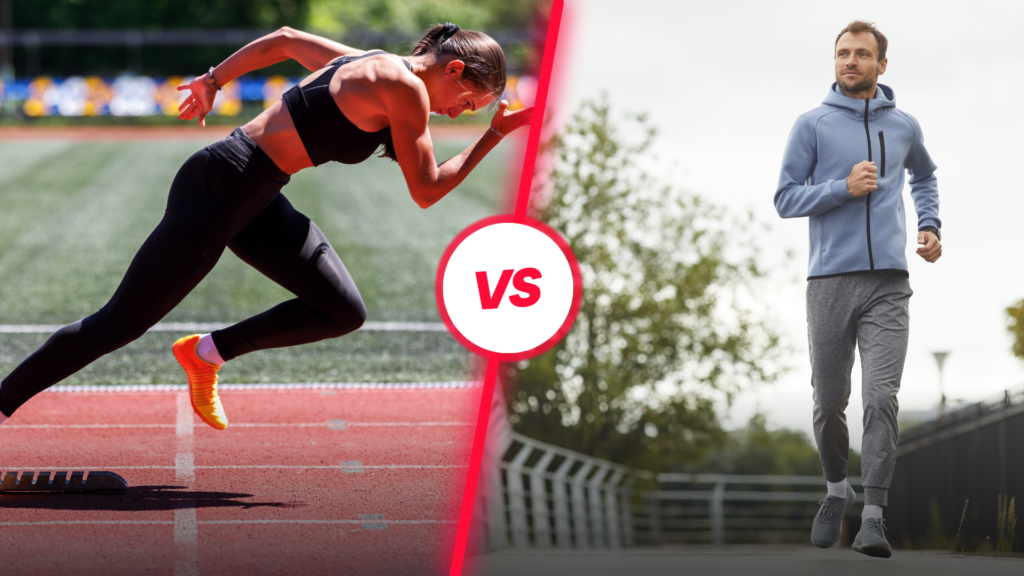HIIT vs. LISS: Which Cardio Training Is Better for You?
When it comes to effective cardio training, two methods stand out: High-Intensity Interval Training (HIIT) and Low-Intensity Steady State (LISS). But which one is the better choice?
In this guide, you’ll learn all about the differences, benefits, and physiological effects of both training methods.

Benefits of HIIT
Maximum fat burning: Thanks to the afterburn effect (EPOC), your body continues to burn calories even after the workout.
Time-efficient: Short, intense sessions are often enough to deliver great results.
Cardiovascular improvement: HIIT boosts both anaerobic and aerobic endurance.
Muscle preservation: Because HIIT involves short bursts of high intensity, it can help maintain muscle mass.
Metabolic boost: HIIT increases insulin sensitivity and improves glucose metabolism.
Drawbacks of HIIT
High physical demand: Not ideal for beginners or individuals with joint issues.
Longer recovery time: HIIT puts a lot of stress on the nervous system, requiring more time for the body to recover.
“Train smart, not just hard – the right mix of intensity and endurance is what gets you to your goal!” 💥
GYMKY
What Is LISS?
LISS stands for Low-Intensity Steady State – a form of steady-state cardio performed at a moderate intensity.
Typical examples include 30 to 60 minutes of jogging, cycling, or swimming at around 60–70% of your maximum heart rate.
Benefits of LISS
Joint-friendly: Ideal for beginners or individuals recovering from injuries
Fat burning: Since your body stays in the aerobic zone, it primarily uses fat as a fuel source
Faster recovery: Compared to HIIT, LISS requires less recovery time
Builds aerobic base: Great for improving long-term cardiovascular endurance
Drawbacks of LISS
Time-consuming: To burn the same number of calories as HIIT, LISS sessions need to be much longer
Can be monotonous: The steady pace may lack variety and challenge over time.
HIIT pushes your limits, LISS builds your foundation – together, they make you unstoppable! 🔥💪
GYMKY

Physiological Differences Between HIIT and LISS
Energy source during training
HIIT: Primarily uses carbohydrates as the main energy source
LISS: Relies mostly on fat for energy
After the workout: Due to the afterburn effect (EPOC), HIIT leads to increased fat burning post-training
Heart rate zones
LISS: Falls into Endurance Zone 1 (60–70% of max heart rate) – ideal for aerobic base building
HIIT: Falls into Endurance Zone 2 (80–90% of max heart rate) – ideal for performance and speed improvements
Nervous system demand
HIIT places significantly more stress on the central nervous system (CNS) than LISS
That’s why rest days between intense HIIT sessions are especially important
Effect on metabolism
Both training methods enhance energy utilization efficiency, helping your body perform better over time.
HIIT improves your anaerobic capacity (short bursts, high effort)
LISS strengthens your aerobic capacity (longer duration, endurance-focused)

Which Is Better – HIIT or LISS?
The choice between HIIT and LISS depends on your individual goals:
Fat burning: Both are effective, but HIIT burns more calories in less time and triggers a stronger afterburn effect (EPOC)
Endurance: LISS is better for long-term aerobic training, while HIIT boosts overall performance more quickly
Muscle preservation: HIIT is better for maintaining muscle mass, thanks to its higher intensity and power focus
Recovery & health: LISS is ideal for active recovery and supports long-term cardiovascular health
The best approach? Combine both methods!
By mixing aerobic (LISS) and anaerobic (HIIT) training, you’ll build a more complete endurance base, strengthen your heart, and maximize fat burning.
Try both and find out what works best for your body and lifestyle! 🚀💪
GYMKY


